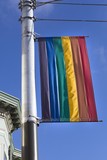Gay neighborhoods have grown in popularity over the years. Originally something of a ghetto where gays and lesbians were almost forced to live due to prejudice, today’s gayborhoods are well-to-do areas with higher than average property values. People flock to them because they want to live there, not because other neighborhoods aren’t welcoming. But with the gay marriage question now settled and more and more people supporting LGBT rights, do these gay neighborhoods have a future? Will most fade away as the LGBT population becomes dispersed across cities?
Property Values
 One reason some gay and lesbian realtors don’t expect gayborhoods to simply vanish overnight is that they tend to have higher than average property values when compared to the rest of the city in which they are located. This means those who own homes in these areas may not want to sell. It may also be difficult for others to move into a gayborhood if they aren’t prepared to deal with the higher property values. Of course, this could work against the neighborhood, too. Without affordable properties, it’s possible younger gay and lesbian couples won’t move to the area, leading to its diversification. However, time has shown that this isn’t the case.
One reason some gay and lesbian realtors don’t expect gayborhoods to simply vanish overnight is that they tend to have higher than average property values when compared to the rest of the city in which they are located. This means those who own homes in these areas may not want to sell. It may also be difficult for others to move into a gayborhood if they aren’t prepared to deal with the higher property values. Of course, this could work against the neighborhood, too. Without affordable properties, it’s possible younger gay and lesbian couples won’t move to the area, leading to its diversification. However, time has shown that this isn’t the case.
The Makeup of the Neighborhood
A joint study done by researchers from both the University of Colorado Boulder and the University of Pennsylvania on gay neighborhoods showed an interesting result: gay men tend to live in close proximity to each other, while lesbians do not tend to cluster quite as substantially. This can be seen in cities such as Seattle and San Francisco. Data from 2000 and from 2010 show that lesbians were much more likely to be dispersed across a city than gay men were. If this trend holds, then we may see the decline of lesbian neighborhoods, but not of gay male neighborhoods.
Location
Some people believe that all gay neighborhoods have some things in common, but that hasn’t proven to be true. While a survey does seem to show that gay men tend to move to neighborhoods that feature more historic, older homes, this isn’t always the case. There isn’t much to connect the various gayborhoods across the U.S. other than the fact that many LGBT people live there. This makes it hard to tell if or when we’ll see new gay neighborhoods form.
The Future
So is there a future for gayborhoods? At the end of the day, experts can’t really say one way or another. They point to the fact that many ethnic groups tend to cluster together despite the lack of reasons for this as a sign that LGBT people may always tend to gravitate towards each other.
